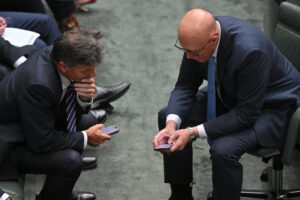by Richard Denniss
[Originally published by the Guardian Australia, 16 September 2020]
At the beginning of the Covid-19 pandemic the Morrison government was adamant that – because the economy would “snap back” once the virus passed – their stimulus spending would be temporary and targeted. Well, you don’t hear much about “snap back” anymore and there is absolutely nothing targeted about the way tens of billions of dollars are being spent by the government.
Let’s be clear, the government’s income tax cuts are perhaps the least targeted or temporary form of public spending imaginable. By definition the benefits of income tax cuts flow entirely to those with incomes above the tax-free threshold of $18,200 – which means not a cent of the benefits will go to those receiving unemployment payments. The regions with the highest unemployment rates and lowest average incomes will get the least support, despite needing it most.
And while it is possible to target income tax cuts at low-income workers, that’s not in the Morrison government’s plan. According to modelling by my colleagues at the Australia Institute, if the commonwealth government proceeds with its plans to bring forward the stage 2 tax cuts, the vast majority of the benefits will go to those on above average incomes, with more than 50% going to the top 10% of taxpayers and 90% going to the top 20%. Those on middle and low incomes will largely miss out. The bottom half of all taxpayers will get just 4% and the bottom 20% will get nothing at all.
Australians have been told for so long that cutting income tax is a great way to boost the economy that people often forget to ask why. It’s a pity.
A lot of economists – including yours truly – are deeply sceptical that cutting income taxes will do much to create jobs or boost economic growth. But leaving us sceptics aside, what’s interesting are the arguments relied on by those who believe tax cuts do create jobs.
Some economists believe that the main determinant of how many hours people work is their after-tax wage rate. The higher the wage we get, the more hours we work; the lower the wage, the less people want to work. Let’s think this through.
There are more than 1 million unemployed people and 1.5 million underemployed people looking for more work. So, if the “benefit” of cutting taxes is that it encourages more people to look for work, then cutting taxes now will only lead to more people competing in the jobs market.
I know, I know – it’s not all about supply, the tax cuts will also “stimulate demand”. It’s true that tax cuts will put a bit more money into some people’s pockets, but so would retaining the jobseeker supplement, giving a one-off $1,000 payment to everyone or directly employing more public servants to help out in hospitals, aged care centres, or anywhere else that needed help. Pumping money into the economy is easy; aiming it where it will create the most jobs takes some skill and creativity.
Any increase in government spending, and any cut in tax, will have some impact on demand, but not all spending and tax decisions have the same effect. If you wanted to get the most “demand-bang for your public spending buck”, you would give the money to the people with the highest propensity to consume. That is, the people who immediately spend the largest portion of their windfall. Overwhelming evidence suggests that low-income earners spend the highest portion of their income but – you guessed it – the government has “targeted” their tax cuts to the highest-income earners who spend the lowest portion.
The government’s income tax cuts aren’t just ill-targeted, there’s nothing temporary about them either.
The government has already provided free childcare and then switched it off again. There’s nothing to stop them making it free again, making university education free, or training and employing tens of thousands of people to help aged care homes cope with the added pressures of Covid-19. As the government has already shown via the short-lived experiment with free childcare, it is possible to turn off the free services tap down the track.
The Coalition went to the last election promising $300bn worth of unfunded tax cuts on the basis that the government expected the economy to be booming. But the economy has just suffered its biggest ever quarterly fall and the government not only still thinks the tax cuts are a good idea, it’s actually considering bringing them forward.
There is no evidence to support the view that spending money on tax cuts will create more jobs than spending the same amount of money employing people to work in childcare or aged care would. And there is no evidence to suggest, even if tax cuts did encourage more people to look for work, that more people looking for work is what the economy needs right now.
Income tax cuts are not temporary or targeted – they are ideological and inequitable. Australia needs a plan to create 1 million jobs, not a bunch of unrealistic assumptions about the impact of tax cuts on incentives.
Richard Denniss is the chief economist at independent thinktank The Australia Institute
Between the Lines Newsletter
The biggest stories and the best analysis from the team at the Australia Institute, delivered to your inbox every fortnight.
You might also like
The Liberal Party defies its own history on tax
For decades, the Liberal Party has prided itself on being the “party of lower taxes”.
5 ways and 63 billion reasons to improve Australia’s tax system
With a federal election just around the corner, new analysis from The Australia Institute reveals 63 billion reasons why our next Parliament should improve the nation’s tax system.
A fair go for temporary workers from the Pacific
On a whistlestop tour of Fiji, Tonga, and Vanuatu in May, Foreign Minister Penny Wong wanted to focus on climate change, security, and aid funding.



